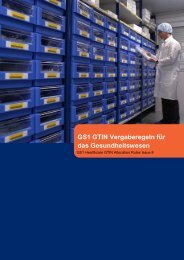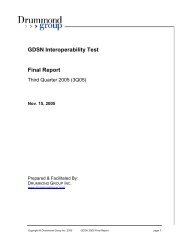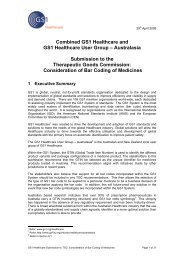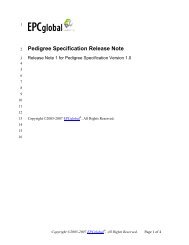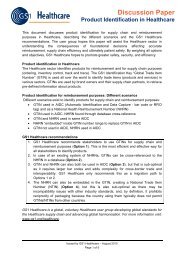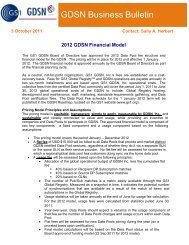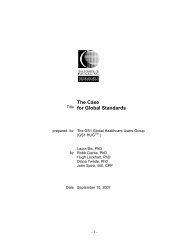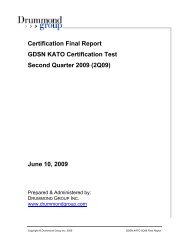Canadian GTIN Allocation Rules for Healthcare - GS1
Canadian GTIN Allocation Rules for Healthcare - GS1
Canadian GTIN Allocation Rules for Healthcare - GS1
You also want an ePaper? Increase the reach of your titles
YUMPU automatically turns print PDFs into web optimized ePapers that Google loves.
<strong>Healthcare</strong> <strong>GTIN</strong> <strong>Allocation</strong> <strong>Rules</strong><br />
2.3. Data Requirements in <strong>Healthcare</strong><br />
2.3.1. Global Trade Item Number (<strong>GTIN</strong>)<br />
By joining a <strong>GS1</strong> Member Organisation the company receives a <strong>GS1</strong> Company Prefix which gives the<br />
company the ability to create <strong>GTIN</strong>s and access to the <strong>GS1</strong> Standards. The <strong>GS1</strong> System is designed<br />
to be used in any industry or any part of the public sector so that an individual company can select to<br />
allocate <strong>GTIN</strong>s using a <strong>GS1</strong> Company Prefix from the <strong>GS1</strong> Member Organisation of their choice.<br />
However, some Regulators impose mandatory local requirements on the use of <strong>GTIN</strong> within their<br />
jurisdiction (see 3, Regulators).<br />
Attributes such as Batch Number, Expiration Date, Serial Number, etc. add value to the product when<br />
combined with the <strong>GTIN</strong> in a <strong>GS1</strong> bar code using the <strong>GS1</strong> Application Identifiers. Their use enables<br />
tracking & tracing systems and can contribute to improving patient safety. For more in<strong>for</strong>mation see<br />
the general guidelines http://www.gs1.org/healthcare.<br />
Within the <strong>GS1</strong> System the following attributes may only be used in association with a <strong>GTIN</strong>.<br />
2.3.1.1. Batch Number<br />
A Batch Number (Application Identifier (10)) is typically assigned at the point of manufacturer using, <strong>for</strong><br />
example, a production lot number, a shift number, a machine number, a time, or an internal production<br />
code. The data is alphanumeric and length is variable up to 20 alphanumeric characters.<br />
2.3.1.2. Expiration Date<br />
An Expiration Date (Application Identifier (17)) is often referred to as expiry date or maximum durability<br />
date and indicates the limit of consumption or use of a product (e.g., <strong>for</strong> pharmaceutical products it will<br />
indicate the possibility of an indirect health risk resulting from the ineffectiveness of the product after<br />
the date). It is always encoded as a fixed length six numeric characters with the structure YYMMDD<br />
where:<br />
■ YY = the tens and units of the year (e.g., 2003 = 03).<br />
■ MM = the number of the month (e.g., January = 01).<br />
■ DD = the number of the day of the relevant month (e.g., second day = 02).<br />
An Expiration Date and Time may also be expressed (Application Identifier (7003)). This structure<br />
is only used when the exact expiration time is critical to patient safety.<br />
2.3.2. Serial Number<br />
A Serial Number (Application Identifier (21)) is typically used on medical devices that need to be<br />
individually tracked and traced (e.g., wheel chairs, pacemakers, MRI scanners).<br />
03 October 2007, Final All contents copyright © <strong>GS1</strong> 2007 Page 9 of 26




